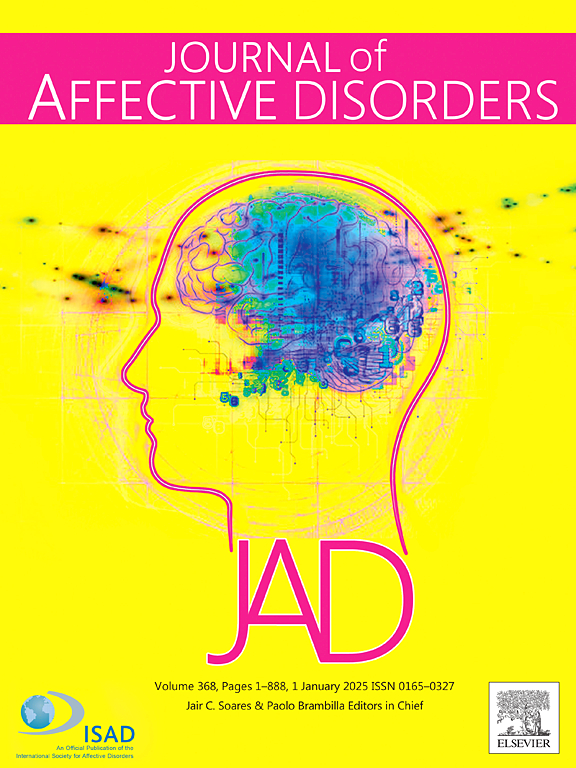Bidirectional relationships between cognitive decline and depression: A study of middle-aged and older adults using cross-lagged panel network analysis
IF 4.9
2区 医学
Q1 CLINICAL NEUROLOGY
引用次数: 0
Abstract
Background
Cognitive decline and depressive symptoms are common in middle-aged and older adults. Two competing theories—Scar Theory and Vulnerability Theory—offer insights into this relationship. Scar Theory suggests depression causes cognitive impairments, while Vulnerability Theory posits cognitive deficits predispose individuals to depression. Understanding these mechanisms is crucial for developing effective interventions, especially in underrepresented regions like China.
Methods
We applied cross-lagged panel network (CLPN) analysis to three waves (2015, 2018, 2020) of data from the China Health and Retirement Longitudinal Study (CHARLS), comprising 14,961 participants aged ≥45 years. Cognitive functions were assessed using the MMSE subscales, and depressive symptoms using the CESD-10. Analyses were conducted separately for males and females, and network centrality metrics were used to identify key bridge symptoms.
Results
The results show that cognitive functions (particularly memory and orientation) predicted depressive symptoms at earlier stage, while hopelessness and low energy subsequently contributed to cognitive decline. Centrality analysis found memory and hopelessness emerged as key bridge symptoms. Sex-specific patterns were also observed: cognitive-to-depressive pathways were more prominent in females, whereas depressive-to-cognitive effects were more pronounced in males.
Limitation
Causal inference is limited by the observational design. COVID-19 in the 2020 wave may have introduced external confounders.
Conclusions
These findings provide empirical support for both the scar and vulnerability hypotheses and underscore the importance of early, symptom-specific interventions—particularly those targeting memory and hopelessness—in mitigating the reciprocal risks of depression and cognitive decline in Chinese aging populations.
认知能力下降与抑郁之间的双向关系:一项使用交叉滞后面板网络分析的中老年人研究
认知能力下降和抑郁症状在中老年人群中很常见。两个相互竞争的理论——伤疤理论和脆弱性理论——为这种关系提供了见解。伤疤理论认为抑郁症会导致认知障碍,而脆弱性理论则认为认知缺陷使人容易患抑郁症。了解这些机制对于制定有效的干预措施至关重要,特别是在像中国这样代表性不足的地区。方法采用交叉滞后面板网络(CLPN)分析来自中国健康与退休纵向研究(CHARLS)的三波(2015年、2018年和2020年)数据,包括14961名年龄≥45岁的参与者。认知功能用MMSE量表评估,抑郁症状用CESD-10量表评估。对男性和女性分别进行了分析,并使用网络中心性指标来识别关键的桥梁症状。结果认知功能(尤其是记忆和定向)在早期预示抑郁症状,而绝望和低能量则在随后导致认知能力下降。中心性分析发现,记忆和绝望是主要的桥梁症状。性别特异性模式也被观察到:认知到抑郁的途径在女性中更为突出,而抑郁到认知的影响在男性中更为明显。局限性因果推理受观察设计的限制。2020年浪潮中的COVID-19可能引入了外部混杂因素。这些发现为疤痕和脆弱性假说提供了实证支持,并强调了早期症状特异性干预的重要性,特别是针对记忆和绝望的干预,以减轻中国老龄化人群抑郁和认知能力下降的相互风险。
本文章由计算机程序翻译,如有差异,请以英文原文为准。
求助全文
约1分钟内获得全文
求助全文
来源期刊

Journal of affective disorders
医学-精神病学
CiteScore
10.90
自引率
6.10%
发文量
1319
审稿时长
9.3 weeks
期刊介绍:
The Journal of Affective Disorders publishes papers concerned with affective disorders in the widest sense: depression, mania, mood spectrum, emotions and personality, anxiety and stress. It is interdisciplinary and aims to bring together different approaches for a diverse readership. Top quality papers will be accepted dealing with any aspect of affective disorders, including neuroimaging, cognitive neurosciences, genetics, molecular biology, experimental and clinical neurosciences, pharmacology, neuroimmunoendocrinology, intervention and treatment trials.
 求助内容:
求助内容: 应助结果提醒方式:
应助结果提醒方式:


